Tips for Quality Run Training Train no faster than one pace quicker than the race you are training for. For example, 5k pace is good for an Olympic-distance race, while half-marathon pace suffices...
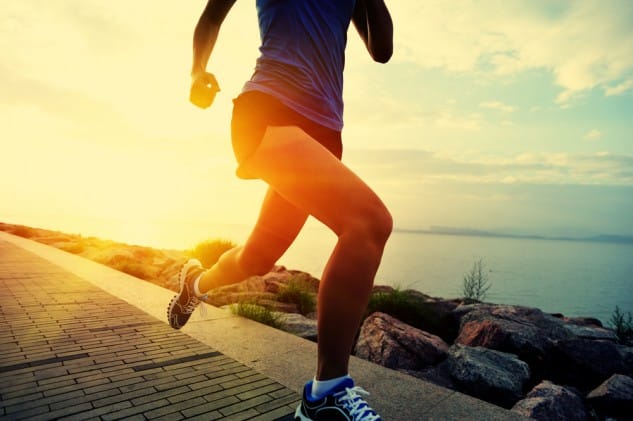

Tips for Quality Run Training Train no faster than one pace quicker than the race you are training for. For example, 5k pace is good for an Olympic-distance race, while half-marathon pace suffices...
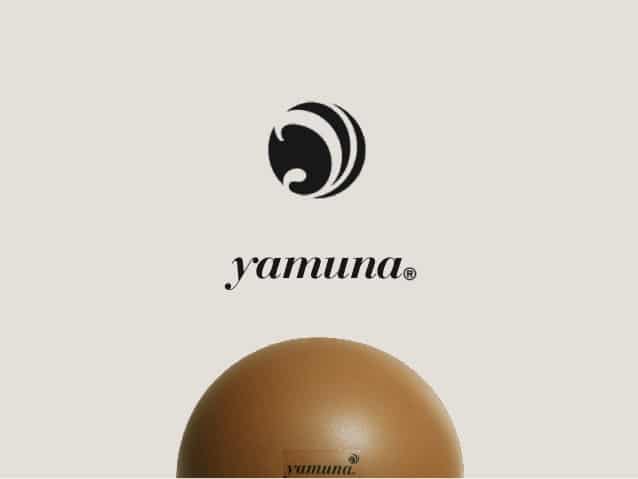
Being immersed in the fitness industry provides me with a ton of different opportunities to experience different techniques, methodologies, and products. I recently had the privilege of a...
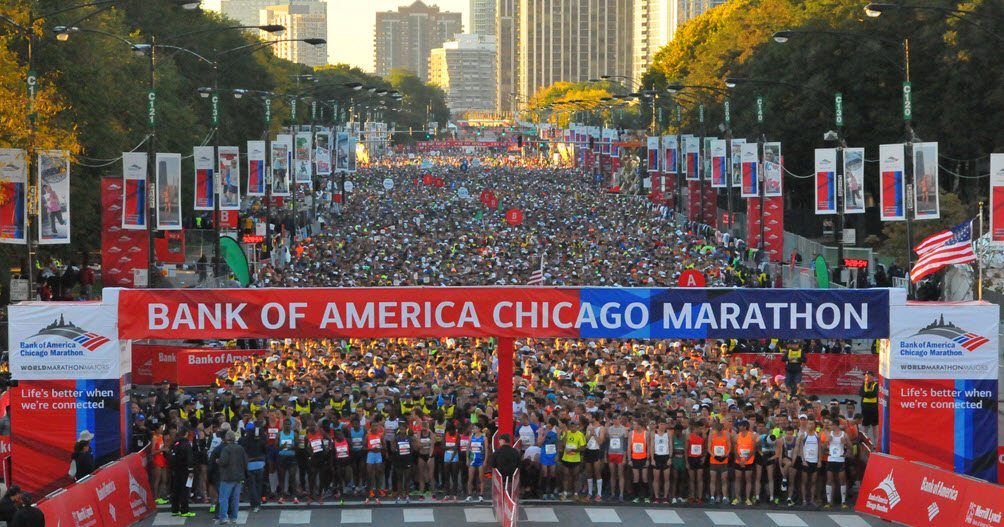
Leading up to the Chicago Marathon 2016 The Chicago Marathon provides an excellent course, plenty of support and, for me, a chance to visit home for a few days. It was no different for me this...
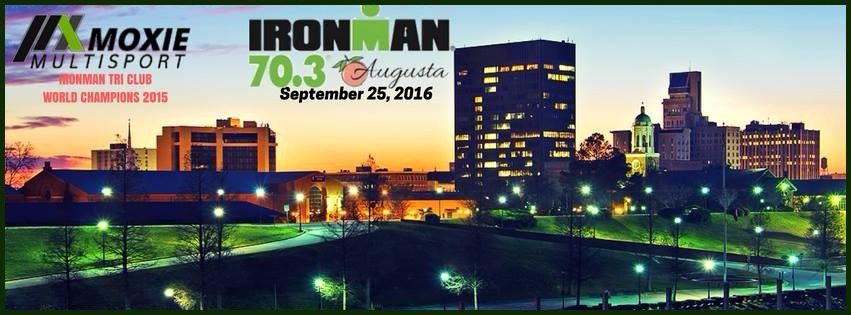
September 25 was going to be my day. The Ironman Augusta 70.3 triathlon was finally here. The race I had been training so hard for on one of my favorite courses. It was four-and-a-half months...
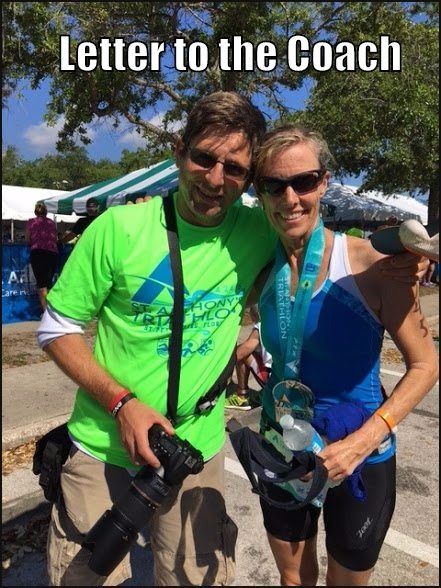
I have been an endurance coach for some time now. Once in a while, I receive an email from a client which chokes me up with pride. Today, I received one of those letters, so instead of sharing it...
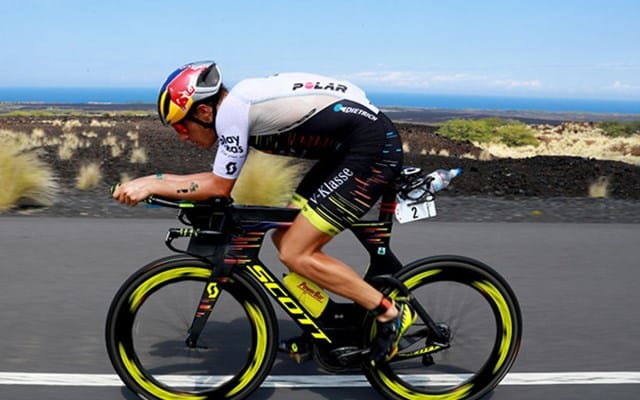
I found when looking for ways to get faster on the bike, is that there is so much information, from different coaches and experts, that it can be confusing and overwhelming. Personally, I...
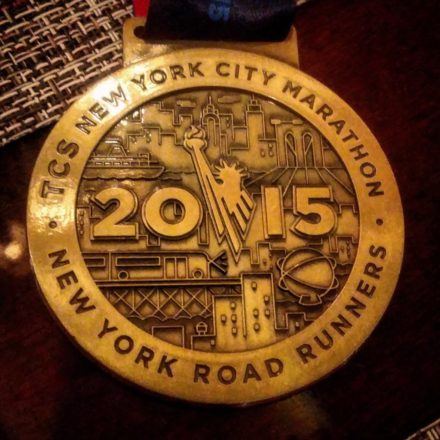
If you didn’t have an opportunity to read the epic writing in the previous post, I discussed the reason “why” I ran the NYC Marathon, then I highly recommend that you do. Not just because the writing was fantastic, but it is my hope that the recap will be more emotionally moving.
Delta carried us to New York City and back with no issues. I was upgraded to the business class on my departing flight, and returned to Tampa in economy class. Even with my average size, I felt extremely cramped in economy. Scott and his six-foot-one-inch frame looked extremely uncomfortable. It is obvious, that Delta increased their upgraded business class at the expense of the comfort of the economy class passengers. My suggestion to anyone flying Delta to the NYC Marathon, just include the cost of the upgrade if the flight it over 3 hours.
The plans were made well in advance for room and board. After each of us declared our opinions for a hotel of choice, one of our teammates found a condo in Chelsea that would accommodate all of us comfortably and provide a full kitchen to save a little money on meals.
Per an email from VRBO (Vacation Rentals By Owner) we were to pick up the keys at a local pizza restaurant located next door to the building housing the condo.
Team Tampa PKD arrived around 4 pm and the employees working that afternoon had absolutely no idea what we were talking about. Of course, we called the management company and were basically told they did not receive the contract. When we had the contract in hand we called the agency back but no one would answer our calls.
Here we were, in New York City, on marathon weekend, not to mention the third and fourth game of the World Series, homeless.
Teammate Kevin O’Brien to the rescue. Kevin works for a landscape development company and happens to travel quite a bit, which was lucky for us. With his Hilton Honors status we were able to procure two rooms at the Hilton Garden Inn located in Tribeca. Thank you Kevin.
The rooms were updated, immaculate and comfortable. Another, nice little value add of the Hilton Honors was the choice of extra points or free breakfast. Kevin being the generous person he is, opted for the free breakfast for us which again helped save a little bit of money. Again, Thank you Kevin.
With all of us now settled, we headed to the Javits Center to pick up our NYC Marathon packets. The bibs numbered up to 72,999. It still amazes me how easy it is to retrieve a bib, swag and t-shirt at the expo. It runs like a well oiled machine.
There is a booth for every few thousand bib numbers. The athlete walks up to the booth that includes their bib number, shows ID and their registration card. Then they receive their NYC Marathon bib and other instructions, verify their info and then walk towards the t-shirt area where on the way, they pick up a plastic swag bag that also serves as the gear bag for the race. The official NYC Marathon t-shirt area is well-marked with a line for the different sizes and within a few minutes of walking into the expo, the athlete has bib, swag and t-shirt.
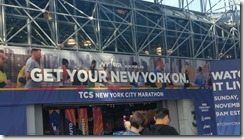
That isn’t the most exciting part of the NYC Marathon expo. There are vendors from all over the country whom give runners have the opportunity to try and buy the latest gear and gadgets.
One aspect of the expo I really enjoy, is the aura and feeling of the environment. There is an excitement in the air of the larger expos that increases my heart rate a little and excites me to race. It is probably one of my most favorite parts of any race weekend.
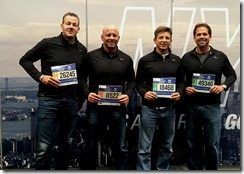
The following day we made another visit to the expo simply to walk around and make some purchases. I found a couple of vendors that I had met at other races and made some new contacts for product reviews. Stay tuned.
I have loved New York City since the first moment I stepped into Manhattan years ago. I have a lot of friends here, and I just really enjoy the pace and excitement of the city.
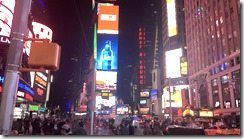
There is always one place, that is mandatory to visit, at least once, every time I am in town. John’s Pizza. I couldn’t believe my ears, when Rich and Kevin decided not to partake. It was their loss, so Scott and I headed over to John’s for lunch. Carb loading, baby, I just love it.
I could write a full post on John’s, so I wont go into the heavenly scrumptiousness of their pizza here, but trust this self-proclaimed, pizza connoisseur, when I say the explosion of flavors that emanate from each bite, redefines the word delicious.
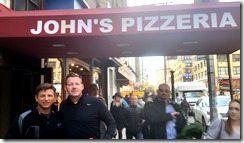


Saturday night, we were scheduled to have dinner with the PKD Foundation and the other runners from different areas at Carmine’s. Scott, Kevin, Karen and I were all pretty familiar with the city and had even known of Carmine’s as it is pretty well-known.
That night we entered the subway and got off at 42nd street in order to head over to 44th where Carmine’s was located, as we started up the stairs from the station, Scott mentions the address which made Kevin and I do a double take. 2400 W Broadway, which was Broadway and 90th street. At the moment we were on 44th st which means we were 46 blocks away. That was a few miles from where we were at that point.
Of course like men we decided that maybe the address was wrong and went up anyway. As it turns out, it was correct. There was a newer Carmine’s uptown and we were in the wrong place and already fashionably late.
It ended up working out for us again. We caught the subway up to 86th and when we arrived, food was just being served. How long could this luck hold, right?
The dinner was fantastic and we met a bunch of really amazing people who were just as passionate about running for PKD as we were.
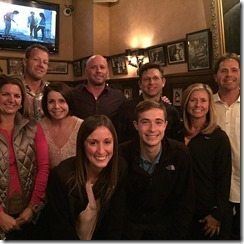
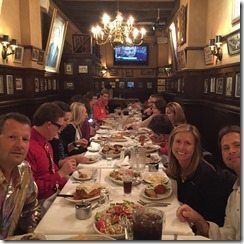
Like good little runners we went back to the hotel and retired for the night in anticipation for the NYC Marathon the next morning.
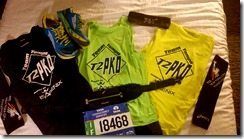
As I mentioned both in the last post and in my NYC Marathon recap from last year; the logistics for this race are not the most convenient. It involves a ferry to Staten Island then a bus to security, a decent walk to the assigned village and finally another walk to the specific corral.
An announcement came out from the NYC Marathon staff, about two months prior to sign up for transportation to the start and of course we all missed and ended up getting assigned the 5:45am ferry to Staten Island. Since three of us had already experienced the ferry and knew that there was no accountability, we decided to just take the 7am ferry instead, not only giving us a little more time in the morning, but also keeping us out of the chilly temps for a couple of hours.
The lesson I learned here was there are two choices, either go by the scheduled time and arrive with a lot of time to spare, sit around have some coffee and bagels while waiting for the start, or go a little later and hope to make it to the corral at the time of your scheduled start.
We took the latter ferry and ended up having to wait for two ferries to get over to the island and then when finally getting on the bus, the traffic was so heavy we ended up having to rush to the corrals in order to make the 9:40 start. It was probably perfect for the rest of the team that had later starts, but for Rich and I it was a little tight. Personally, I do prefer the latter.

I found my green village, dropped off my gear bag with my long sleeve shirt and pants, and headed to the corral just prior to the 9am cut-off to enter the corral. Now I had about half-an-hour to stretch and use the portlet one last time.
I was talking to a woman from Basel, England when I heard my name being called. Ryan Wallace, was a Facebook friend and runner I met at last year’s race. A really fun guy to hang with, so after chatting for a bit we found we were looking at accomplishing the goal of 3:50 or better. Score! Someone to run with.
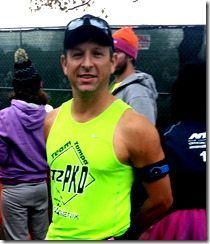
In the Start Corral
They opened up the corral to head closer to the start line around 9:30am, and just after the final note to one of the most beautiful renditions of our national anthem I have ever heard, sung by opera singer (and runner) Susanna Phillips Huntington, and announcements by the executive director, the gun went off and we were running.
The NYC Marathon is the largest marathon in the world. Largest meaning the most athletes run the course of any marathon in the world.. This year there were over 50,000 finishers. It boasts spectacular views, fantastic support from the spectators, and a challenging course. The route takes the runners through all five major boroughs of the city, starting in Staten Island, crossing the Verrazano Bridge to Brooklyn, heading north into Queens crossing the 59th St bridge, then into Manhattan crossing the Queensboro Bridge, north into the Bronx over the Willis Ave Bridge, turning south back into Manhattan over the Madison Avenue bridge and then finally the incline to the finish line in the heart of Central Park.
The experience this year was better than last, as the temperatures were much better as we started around 55 degrees Fahrenheit and just a little breeze versus the 30 degree temps and 33 mph winds from 2014.
Ryan, his friend, and I started the NYC Marathon conservative for the first couple of miles, but as we rounded the first 5k I noticed we started to increase our pace. I only was witness to it due to calculating my 5k under 27 minutes, which being under a 9 minute mile that soon, concerned me a little, but I was feeling really strong.
The spectators in the NYC Marathon are everywhere and they clap, yell and scream not only for their family and friends, but for any one they seem to be inspired by. Statistics pretty much show, that even know there were over 50,000 athletes running this race, and hundreds of thousands of finishers in marathons all over the world, less than 1% of the population has finished a marathon. In other words there were a lot of people to be inspired by during this race and the spectators expressed that.
Ryan and I ran together up to about mile nine, constantly telling each other to slow down, yet neither of us could hold a slower pace for very long. About that point, a pressure emanating from my bladder was increasing to a point where I was just not comfortable any longer, so I speeded up to the mile 10 aid station to relieve myself. My thinking was speed up, use the facilitates and then speed back up just enough to catch Ryan again.
Unfortunately, we didn’t cross paths again during the race. I was out there on my own, all by myself. It was just me and 50,000 of my closest friends.
There was plenty to see as I continued on my NYC Marathon journey. Achilles International volunteers were out in droves this year with guides helping blind and other challenged runners through the race. Guides would run in a formation with one tethered to the blind runner and then three-to-four others running on each side of them constantly helping to clear a path through the crowd. It was so motivating, that I knew somewhere down the line in my own journey I would have to help like that in some way in the future.
As I crossed the 13.1 mile marker of this NYC Marathon, and saw the clock I realized that I had been running for an hour and fifty minutes. That for me was fast, but I was still feeling really strong. The sights of the area’s architecture, parks, people and the smells of the local restaurants were consistently keeping my mind occupied as I just let my legs decide what they were going to do.
I was concerned though. I know enough about myself, that keeping this pace would have it’s consequences toward the final miles.
My favorite bridge on NYC Marathon course is the Queensboro bridge. It feels like it never ends, but the view of Manhattan and the Hudson is spectacular. Not to mention, the completion of the bridge is a u-turn with a horde of spectators that it feels like a roar of excitement is exuded from them. I felt a boost of energy when I crossed mile 16.
I was actually a little impressed with myself as I hadn’t really slowed as of yet. It is usually around this mile marker that begins the stiffness of the previous miles.
The next checkpoint for me is usually mile 18, but that too came and went without any real pain. My inner dialogue started having delusions of grandeur of possibly finishing the race around the 3:40 mark which be a huge PR for me.
As I crossed the Willis avenue bridge, I felt the start of a twinge in my left leg and a smile crept across my face and out loud I said to myself,”There it is.”
The NYC Marathon mile 20 clock showed I was two hours and fifty-two minutes into the race, which was already better than last year. My thinking at that point was that I could pretty much slow to a ten minute mile at this point and still cross under four hours, but that didn’t happen.
Mile 21 came at just three hours which was a first in a while for me. I am usually only at 20 by three hours and here I was a full mile closer to the finish. My period of optimism was cut short by a stiffness in my right leg that quickly became painful.
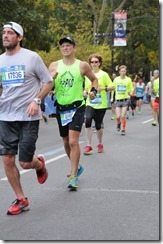
I walked though the next NYC Marathon aid station and grabbed a banana from the hand of a volunteer thinking just get some more glycogen to my legs so I finish this last five miles.
What little stride I had became periods of walking between miles 22 and 23 as the pain started to sear and engulf the rest of my leg. It was getting harder and harder to bend my right knee as the stiffness was setting in.
Central Park came and the crowds were getting louder and more dense. I did not want to walk through the park with all these people. I wanted to run in strong, but the pain was getting more and more intense. I actually yelled at myself, “C’mon legs. WTF are you doing!!!”
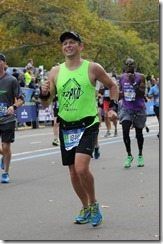
My mind drifted to Erika at that moment. As I was trying to run stiff-legged and just suffer through this intense pain, I thought that this frustration and uncomfortable feeling must be what Erika feels all the time. The disappointment at feeling run down, the pain that comes with these huge cysts on her Kidneys and the eternal uncomfortable feeling that keeps her from sleep and just enjoying life, must be one hundred times worse that what I was feeling.
If Erika had to continually go through this pain, then I could at least endure it until I reach the finish line.
I didn’t stop running, no matter how much it hurt. I thought about Erika and the last couple of years of misery she must have been going through, and how Jennifer would also have to also have a painful times ahead through her recovery from donating a kidney. It kept me going as I really felt like I was going through it for them.
I am not a totally idiot, I know that running the NYC Marathon of which I enjoy doing, really would do nothing for either of them. It was the fundraising and support where we as a team were doing the most good. Maybe it was for me. Maybe because I was not able to donate my kidney, that I the pain I was feeling now was so that I could empathize with both of them.
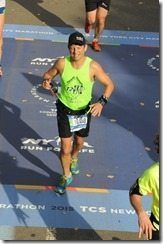
The NYC Marathon finish line was just as glorious as the other marathons I have completed. I was extremely happy to cross in 3:56 and at least beat my time from last year by about 10 minutes.
My official NYC Marathon finisher was medal handed to me, I was congratulated by a volunteer and ushered through to take continue the long mile walk to retrieve my gear bag. I was engulfed on all four sides with athletes as we all did the marathon shuffle through the park. There was a sense of peace and a little giddiness that filled the air.
We all did something extraordinary today. Whatever the reason “why”, we were bound at that moment by the accomplishment and conclusion of a journey that started with the decision to embark, the hours of training and the final step across the NYC Marathon Finish LIne.
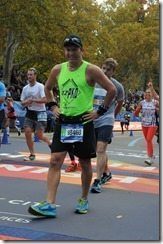
Once dressed in dry clothes, I found Rich and we headed out to The Keg Room which was where Team Tampa PKD would gather back together. As Rich and I were in the first wave, where he PR’d at an incredible time of 3:27, we arrived first. Kevin, whom was actually in the last wave to take off, showed up next followed closely by Karen and finally Scott. Everyone finished and accomplished what they set out to do, but I was most proud of Scott.
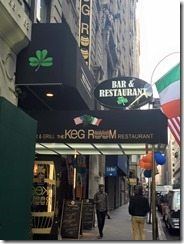
Scott had micro tears in his gastrocnemius muscle (Calf) and had been trying to rehab it for the last couple of weeks. I really didn’t think he would finish the NYC Marathon and we all told him it would have been ok if he didn’t . He did though and under 5 hours with walking. He also said that he felt like he didn’t feel like he did anymore damage.
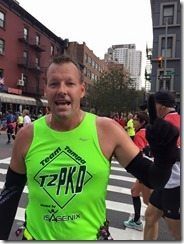
Scott Bragan
I am proud of the whole team. Team Tampa PKD was able to raise over 20,000 for PKD, finish the NYC Marathon and, most importantly, find a kidney donor for Erika.

Team Tampa PKD – (L to R) Scott Bragan, Rich O’Dea, Karen Dempsey, Brad Minus, & Kevin O’Brien
What kind of challenge are you partaking in or plan to journey towards?
Carpe Vitam!
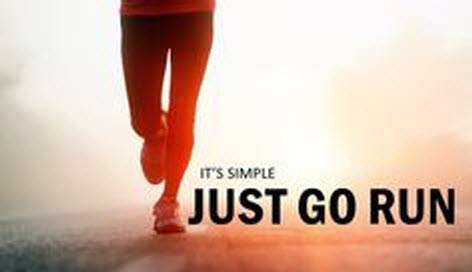
Happy Hump Day! Workout Wednesday’s will consist of favorite workout of mine that I either have prescribed to my clients or have been assigned by MY Coach. It might also be a favorite of yours. Feel free to send me any workouts you like. There will be an objective for every workout for specificity.
I am not a huge fan of weights or being in the gym. As the summer wore on and Florida continued to increase in heat I found myself spending more and more time in the gym and on the treadmill, but I still prefer to be outside. This workout will work leg strength as a replacement for a gym resistance workout or a supplement to. It can be done either on the Treadmill or outside with a hill that takes 2-3 minutes to run up, or here in Florida we use parking garages.
WU (Warm-up): Run Drills & Dynamic Stretching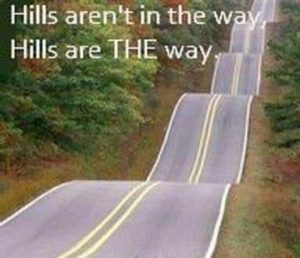
1-2 miles @ conversational pace
MS (Main Set):
Hill Bounders on uphill
Recover for 30 sec – 2 minutes
Speed over strides on Downhill
Repeat for up to 30 minutes
CD (Cool Down): 1-2 miles @ conversational pace
Lunges & Static Stretches
Objective: Leg strength, Aerobic capacity, Form Development & Confidence on Hills
Rate of Perceived Exertion (RPE): 5-7 on the uphills (Talking should be very difficult)
Description: Run a hilly course. Do not try to run fast on the uphills but rather concentrate on a good knee lift, strong arm swing, uplifted chest and full push-off extension in your back leg. Practice running efficiently on the downhills with high turnover and enough of a forward lean that your front leg lands directly under you.
Hill Bounders: go up the hill with a bouncy action and a good posture, concentrating on a good knee lift and arm swing with a “snap” with your ankle. You should be thinking Spring up the hill. Jog until recovered at the top.
Speed Over striders: Run down the hill with out breaking but increasing your cadence with the steepness of the hill. Instead of completely striding out elongating your stride, focus on increasing your cadence with a normal stride.
Biggest Mistakes: Running too fast up the hill rather than concentrating on form. Running too hard up the hill and getting into too much oxygen debt. This is not desirable in this phase .Putting more stress on the legs than they are ready for with too much bounding or downhill running and getting injured. Precipitating your peak with repeated speed bursts. Some people tend to develop speed very quickly once they start doing the hill circuit. If this is the case, go very easy with downhill striding and on the stride-outs. You’ll still have plenty of time to develop speed to maximum. Premature speed development would only lead to premature peaking and this should be avoided.
Warning: The first week of hill training is one of the times where injury is most likely to occur. This is a very demanding exercise, so be overly cautious and feel your way gradually. After about 2 weeks in this phase your legs could feel very tired and you may feel you’re actually slower. This is normal and will pass within a couple of weeks of consistently completing the workout.
I hope you enjoy this one. I know I do.
What kind of workout do you do for run strength?
Carpe Vitam!

It has been a while, and I have a ton of ideas that I am anxiously awaiting to share with you. Unfortunately, time has been getting away from me. Between training myself, a full-time job and being at capacity with 15 individual clients I am struggling for time to post. I promise I will figure out a way to make time. I am so lucky to have such great people to bounce ideas off of, that sometimes, by not posting, I feel like I am letting all of you down, so I promise to post more even if the posts end up being a lot shorter than usual. (Which the length is probably not your favorite part of it anyway. I know I ramble.)
Before I get into the nitty-gritty of my personal opinion of compression, a disclaimer.
I am not a medical professional. The opinions that are shared on this post come from research, my own experiences and the experiences of athletes I have personally witnessed and information I have researched. Every athlete/person has a different body and some products and/or methodologies may be advantageous for some and may even be dangerous for others. This post deals with my beliefs and my research. (Was that clear?)
Lately, most of the questions from other athletes, including clients of mine, have asked about compression. This usually centers around calf sleeves, but does include some of the other compression apparel as well. My answer is usually, for recovery and for temporary use they are great, but not for training. Why? Great question.
I am going to use calf sleeves as my example.

While running, biking, swimming or any major activity using the legs, the muscles are constantly in motion. That motion is what naturally makes the muscles stronger. The muscle moves and is loaded with either more repetitions, or with weight. The full range of motion of each muscle is imperative to the strengthening of the muscle. Compression holds that muscle in place and limits the movement therefore limiting the range of motion. While compressed the muscle cannot fully develop while training. Let’s take a look at the anatomy of the lower leg in the running position.


As you can see the gastrocnemius muscle and Achilles tendon, when the knee is flexed, both constrict and then elongate when the knee straightens. Here is the epitome of the range of motion naturally occurring when running. The more flexion and constriction that take place the more they are stretched causing the breakdown of the fibers. After the recovery period the fibers wrap tighter and in more abundance aiding in a strength and endurance. Now imagine that gastrocnemius muscle remaining constricted due to a calf sleeve. It seems to me that this would dictate that it would not have full range of motion also causing the Achilles tendon to remain stretched without the full ability to absorb the impact. This could unintentionally damage the Achilles tendon, the gastronemius muscle and the soleus muscle. If not damage, it will limit the ability to be strengthened. This is why I personally do not recommend calf sleeves during training workouts.
Recovery
I do however do not mind wearing compression while in recovery to include immediately following the cool down of a workout. I mentioned the healing of the fibers earlier. In order for the fibers to heal and become stronger after the breakdown, blood must be pumped through the muscle and with it water for hydration. Compression does help to isolate that area helping to keep the majority of the blood and water being pumped through the body to the point of the compression. With the legs either elevated or even walking around and at that point limiting the movement, it would allow for the blood to pool in that area helping to re-hydrate the muscle thereby helping to heal faster. In turn, an occasional training run or race, with compression at the tail end of an injury, might also benefit, but in a very limited quantity, and duration.
–IronGoof

One of the scariest things for a beginning triathlete, besides getting in the open water, is cycling. The first image that wandered into my head upon deciding to start seriously bicycling was of a that scary peloton. Those tight formations of bikes moving at ridiculous speeds, during the Tour de France, so close together that one wrong move could cause serious damage to my body or someone else. Scary right? Luckily, triathlon doesn’t allow for huge groups like that, as a matter of fact it isn’t even allowed. Whew!
Buying my first Bike
I didn’t have a lot of money when I first started in triathlon, and I also didn’t really know if I was going to like it. I spent a lot of time in bike stores drooling over the expensive bikes, while studying cheaper entry level bikes. Every bike store had a different angle they played. One would say, purchase the more expensive bike, gain more speed so when I improved I didn’t have to buy another bike. Another would tell me to buy the entry level but load it up with expensive components so I could ride faster, and when I wanted another bike, the components alone would warrant a good price, and of course that store would buy it back from me and give me a discount an another bike. Decisions, decisions what to do, what to do?
I researched different road and tri bikes online and in magazines, and while I was pretty sure I would enjoy triathlon, I decided on an entry level Canondale CAAD 9 road bike. I also included in my purchase, a pair of pedals, cleats, shoes and a helmet. The helmet was very important especially since I hadn’t actually rode a bike in over 10 years. Would I really not forget how to ride a bike? The answer to that my friends is YES. It is not a skill that is forgotten. It maybe a little unsteady the first couple of times, but not forgotten. Luckily I will have my trusty helmet, just in case.
I would enjoy triathlon, I decided on an entry level Canondale CAAD 9 road bike. I also included in my purchase, a pair of pedals, cleats, shoes and a helmet. The helmet was very important especially since I hadn’t actually rode a bike in over 10 years. Would I really not forget how to ride a bike? The answer to that my friends is YES. It is not a skill that is forgotten. It maybe a little unsteady the first couple of times, but not forgotten. Luckily I will have my trusty helmet, just in case.
I also read something that resonated with me. The most important thing that is needed after the purchase of a bike, is the fitting. At first I thought, “what? Don’t I just have to find the most comfortable height of the seat and then get going?” I had no idea that there are so many different adjustments on a bike, to a point that bike “fitters” actually have to be certified in order to properly fit you. They have to take courses, pass tests and be mentored. “Really?”, you ask? Yes…really.
The fitting took about an hour where they put my bike on a trainer, and with my shoes and bike shorts I pedaled, then the fitter took measurements and made adjustments to my seat post raising it and lowering it to a perfect dimension. Then he took angle measurements from the ground to my hip, knee and shoulder and from the pedal and a bunch of other places. He moved my saddle not only up and down by forward and back. He then took my handle bars and put different size spacers on the tube underneath my handlebars to find the perfect height and then was able to move them back and forth to find the right angle, height and most comfortable spot for me. I had no clue there was this much to it.
Pre-First Ride
As I left the store after my fitting, Jo-el, the general manager and friend from my track club, gave me some good advice. I had never rode in cleats and pedals before, where my feet were clipped into the pedals where they wouldn’t just simply lift up. I had to turn my heel so the cleat would unclip from the pedals so I could put my foot down. Jo-el said to take my bike in the house and put it between a doorway, and practice clipping and un-clipping from the pedals. Also, I needed to find the most comfortable side to unclip first and then stick to that side no matter what. I followed that advice in detail. I clipped, unclipped, clipped and unclipped till I was sure I had mastered it. Then I took a little ride around the block and practiced even more till I was confident I mastered at least that part.
I had a feeling of euphoria that first little trip in my neighborhood. I felt fast, free traveling under my own power on this brand new, tuned Cannondale bike. I was really excited for my first ride the next day in the hills of San Antonio.
The First Ride
I drove to San Antonio…Florida that is, with my brand new bike in the back, my new bike shorts on, bottles ready to put in their cages on the bike, coffee in my cup holder and classic rock playing on the radio. I remember having mixed feelings about this initial ride. I had never ridden in a group before, I had never ridden with these cleats and clips before, but I knew I was in good shape but was I fit enough? After that I just thought to myself, “if you cannot go as far then just turn around and head back. no big deal.”.
I met a friend at these ball fields and was mesmerized by the amount of bikers getting ready to take their morning ride. The sea of colors from the different bikes and jerseys was extremely overwhelming. That anxious feeling came back for a second until my friend mentioned we were riding with triathletes not pure cyclists. They would understand I was on my first ride and would help me out. After preparing for my first journey, we found our formation and began the trek.
I was surprised that I was staying in the middle of the pack and with minimal effort. The wind was in my face, I was pedaling under my own power and keeping up! It was an incredibly euphoric feeling. Unfortunately, when we hit the first long hill, euphoria turned to anxiety and then… embarrassment.
My pedaling slowed, and it became extremely hard to mash down on the pedals. With very minimal spinning of my legs I tried to switch to higher gear, but I actually ended up in a lower gear which made it even harder. When I did finally gear up, it was too late. I couldn’t move the pedals fast enough to switch gears, and my chain fell off , so I was at a dead stop. Of course I was so concerned about the gears I didn’t unclip out of my pedals, and I went down on my side. The only thing that really hurt was my ego as I stood my bike up and examined the chain. The group was passing me all asking if I was ok, and taking for granted that I was telling them I was fine and to keep going. By the time I had my chain back on the group was completely out of site. I pedaled like a bat out of hell hoping to catch up, but I missed a turn and ended up 10 miles out of my way, and lost.
To make a long story short ( I know, too late) one of the faster members of the group realized I was gone, backtracked, and finally found me asking directions at a convenience store. He led me back to the group and I finished the ride without any other issues, but I learned a lot of lessons that day.
Hints to get started in cycling straight from the Goof:
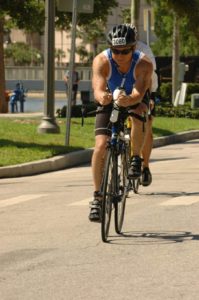
On my first bike after a couple of modifications
1. Buy an entry level road bike. This is usually an aluminum alloy frame. You don’t want a Wal-mart special, but you don’t need to start with the top of the line bike either.
2. Purchase a set of entry level pedals, cleats and shoes. The pedals usually come with the cleats and the bike shop will install them for you.
3. Purchase safety equipment. Biking shorts, and a helmet to start. I would also have a set of sunglasses as well. Not just to keep the sun out of your eyes, but it helps with the wind too. Make sure you also have at least one water bottle with a cage installed on your bike.
4. Get the bike fit for you. Have a certified bike fitter make those adjustments specifically for you.
5. Practice getting in and out of your cleats . Put your bike in a doorway, hold onto the frame and get in and get out of your cleats. Find the most comfortable side of the bike and then practice getting out of the cleats and putting your foot on the ground.
6. Take a short ride around your neighborhood and continue to practice getting in and out of your cleats. When seeing a stop or even a potential stop ahead practice just moving your heel just to the point where you unclip before stopping so you have a quick option that you can pull out of your clip to stop or return your heel to clip back in to keep going. Remember to always clip out and stand with the same foot first every time.
7. Understand your gears. While in that first ride, switch the gears on your right hand and find what lever takes you to a higher or easier gear, and which one brings you to a lower or harder gear.
8. Take your first long ride with friends and have some fun.
One last thing, you are going to fall. That is just the reality of it. You will get stuck in your cleats at some point and you will fall over, but it will be minimal. The trick is to accept it, get up brush yourself off, laugh at yourself, get back on your bike and have fun. It’s worth it I promise.
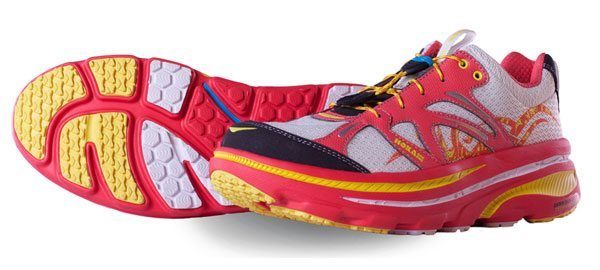
Hoka One One Biondi S2
Have you ever even heard of these shoes before? I didn’t before I met Chet “The Jet” whom was a double Ironman athlete I hosted in my home a few weeks ago. Chet is from Hawaii and he nonchalantly mentioned these shoes as he was telling the tale of his son whom was running across the country. He was even went on to mention that he sent a pair to a point in Alabama where he knew he son could pick them up, and the response, nothing but sure gratitude for the gift. That was the point I had to give them a try.
Hoka One One is not well known here on the east coast, but in the community of ultra runners they have been known since their inception in 2010. Obviously this is a relatively young company which falls under the Deckers Outdoor Corporation umbrella whom also houses brands like UGG, and Teva. With the increased popularity of Ultra and Marathon running, I believe these will take off to even higher levels in the very near future. Why? Well let me tell you.
When I looked at these shoes for the first time, I reacted negatively. The huge sole, was a 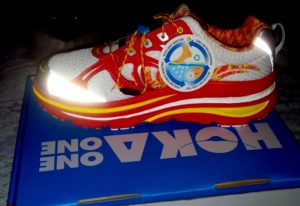 problem for me, due to my belief in a more of a minimal running form, but I for the readers and for my clients I wanted to give them a try, especially after the rave reviews from Chet and his son. I decided to take them out first for a three-mile run, and then give them a full test drive at the Sarasota Half-Marathon this past Sunday. I was completely overwhelmed at how comfortable and responsive these shoes are. At first glance they look really heavy don’t they? They weigh in at slightly under 10 ounces(9.8), which is the exact weight of my Brooks Pure Flow 2s that I love so much. My Brooks Pure Cadence 2s, I was just sent are actually almost 0.4 ounces heavier. (Just a disclaimer, I weighed these myself, I did not take these stats from the website.)
problem for me, due to my belief in a more of a minimal running form, but I for the readers and for my clients I wanted to give them a try, especially after the rave reviews from Chet and his son. I decided to take them out first for a three-mile run, and then give them a full test drive at the Sarasota Half-Marathon this past Sunday. I was completely overwhelmed at how comfortable and responsive these shoes are. At first glance they look really heavy don’t they? They weigh in at slightly under 10 ounces(9.8), which is the exact weight of my Brooks Pure Flow 2s that I love so much. My Brooks Pure Cadence 2s, I was just sent are actually almost 0.4 ounces heavier. (Just a disclaimer, I weighed these myself, I did not take these stats from the website.)
What also surprised me was the structure looks like a normal running shoe, like any Asics Nimbus, or Brooks Ghost which has a 12mm heel drop. They say looks can be deceiving, and with these shoes they are. They also have the same heel drop as the Brooks Pure Project line as well. The flexibility in the forefoot is probably the only disadvantage of this shoe versus my own running shoes and even that is minimal, and I believe probably after running in them for a little longer even that would become pliable enough to create more flexion.
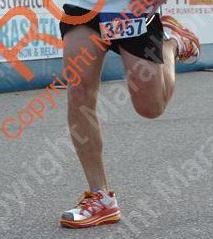 The sole not only provides superior cushioning upon impact, it also is slightly wider which increased the stability as well. It seriously was like running on a cloud. I always preach good running form, and if you have naturally good form, impact is not usually an issue due to a proper lean, raised knee, and high cadence. I found myself not having to think about my posture and position, because the rocker-ed sole of the shoe did not inhibit, but encouraged a good strike and lean. Just for the fact a few of my clients are still trying to get into the habit of good form, I decided to jump rope, and do some box jumps in order simulate the impact. I barely felt anything, and I had full control of my feet. i really thought I would end up kicking the rope especially doing double-unders, but I had complete control and I barely felt the impact doing the box jumps. I could totally understand why these shoes are so popular with the marathoners and ultra-runners on the other coast. The more people start wearing them here, I believe they will gain popularity pretty quickly.
The sole not only provides superior cushioning upon impact, it also is slightly wider which increased the stability as well. It seriously was like running on a cloud. I always preach good running form, and if you have naturally good form, impact is not usually an issue due to a proper lean, raised knee, and high cadence. I found myself not having to think about my posture and position, because the rocker-ed sole of the shoe did not inhibit, but encouraged a good strike and lean. Just for the fact a few of my clients are still trying to get into the habit of good form, I decided to jump rope, and do some box jumps in order simulate the impact. I barely felt anything, and I had full control of my feet. i really thought I would end up kicking the rope especially doing double-unders, but I had complete control and I barely felt the impact doing the box jumps. I could totally understand why these shoes are so popular with the marathoners and ultra-runners on the other coast. The more people start wearing them here, I believe they will gain popularity pretty quickly.
The retail price of the Hoka One One Biondi S2s are $170.00 which seems even high for a running shoe, but like the Newtons, they have a much higher mileage output. In my research I have found these shoes have been averaging over 700 miles without any degradation of the sole or cushioning. An ultra runner friend of mine said he had 3 pair of these he was switching out, and his current count is at 3048 miles and he has no intention of getting new ones yet. Most running shoes will get up to 350 miles, and my favorite Pure Project line rates there own shoes at 250 miles and cost around $100 retail.
They do take some getting used to. They do feel bigger, but not heavier. I do like that I was 5’11’ with them on, instead of 5’8″ and change. Personally, I do not think I would use them for a half marathon or below. I like the feel of the road a little too much, but you better believe I will be running the Chicago Marathon in them.
I give the Hoka One One Biondi Speed 2s, 4 out 5 Goofs.
Hoka One One has several other versions of shoes, for different fits, and surfaces. More information can be found on their web site.